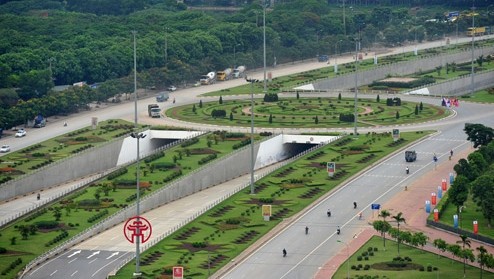Following passage of Resolution 15, which tripled the area of the city to over 3,328 square kilometres, it has sprawled out and now encompasses the whole of neighbouring Ha Tay province, Me Linh district of Vinh Phuc province and four communes of Luong Son district, Hoa Binh province.
The city’s population now numbers over 7 million with its inhabitant’s living in 577 communes in 29 districts and towns.
Over the past five years, the capital city has strived to live up to its role as the heartbeat of the country and as the national political and cultural epicentre with its finger on the pulse of the socio-economic development of the nation.
The city accounts for over 10% of the nation’s GDP, with its economy having posted an average growth rate of 9.51% during 2008-2012, which was 1.5 times higher than the national average rate.
Its export turnover has soared up to US$10.3 billion in 2012 from US$6.9 billion in 2008.
The city revenues account for over 20% of the State revenues, and amounted to VND146.3 trillion in 2012.
“What Hanoi has done is quite remarkable and comprehensive considering the difficulties in the national economy,” Secretary of the municipal Party Committee Pham Quang Nghi told the Vietnam News Agency on the occasion of the fifth expansion anniversary.
“Residents in former Ha Tay province, Me Linh district and the four communes of Luong Son district which are now an integral part of Hanoi are all the more proud of the city’s development. The positive changes in the city have been highly valued by local people and international friends,” Nghi said.
There have been numerous developments in the fields of socio-culture, education and training, health, science and technology while urban planning, construction and management have seen remarkable improvements. Added to this, urban and rural infrastructure has been strongly developed, especially key transport projects.
“The reality over the past five years proves that the Party Central Committee, NA and Government made the right decision in expanding the city’s administrative boundary, which is of historic significance and reflects a long-term vision for not only the capital city but also for the development of the nation to meet the demands at a period of economic and social change into an industrial society,” NA Chairman
Nguyen Sinh Hung said at a meeting on July 31 to review five years after Hanoi was expanded.
The NA Chairman asked the capital city to continue striving for sustainable, quality and effective economic development, with increasing competitiveness while ensuring social security and taking lead in building an advanced culture imbued with strong national characteristics.
In further implementing the NA’s resolution, Hanoi is determined to effectively carry out the development orientation and tasks for the period from 2011-2020, building a civilised living environment with educated people to keep up its reputation as the city with a thousand-year–old civilisation and the world’s city of peace.
















